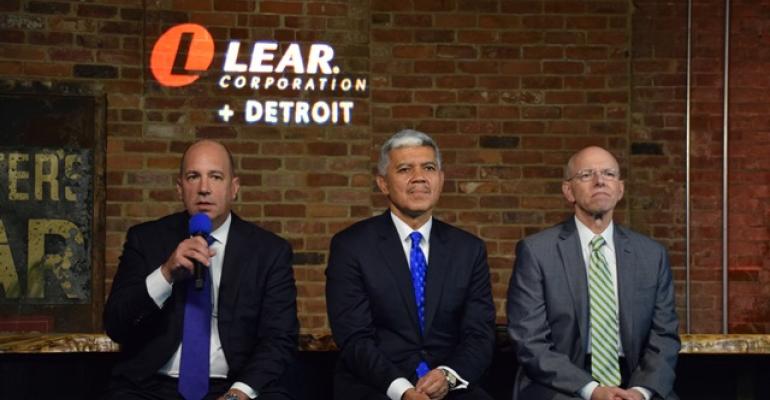DETROIT – Eager to join in the revitalization of this city rich in automotive history, supplier Lear spends $10 million to turn an 1880s cigar factory downtown into a 6-story idea incubator where designers and engineers will work with college students on products of the future.
Much of the work at the Lear Innovation Center will be dedicated to automotive technologies. But a fair amount of research will focus on non-automotive products that could spring from Lear’s reach into other industries as a result of its recent acquisition of fabric producer Guilford Textiles and connectivity specialist Arada Systems.
Starting out 100 years ago in Detroit as American Metal Products, Lear supplied tubular, welded and stamped assemblies to the aircraft and automotive industries. About 20 years ago, Lear and other top interior suppliers began positioning themselves to be a one-stop source for complete interiors, from dashboard to back seat and from carpeting to headliner.
That model failed miserably, following a similar trajectory as General Motors and Chrysler lapsed into bankrupty in 2009, forcing Lear, Johnson Controls, Magna and others to sell off massive parts of their interiors businesses. Lear also went bankrupt in 2009.
With its world headquarters nearby in Southfield, MI, Lear held on to its core seating and electronics operations, and business has been healthy enough to support growth in overseas markets and other key acquisitions. Lear purchased leather producer Eagle Ottawa in 2014.
By virtue of the Guilford deal, Lear gained a foothold, literally, in the textiles business, supplying fabric for New Balance tennis and running shoes, as well as other sports apparel from Under Armour and Nike.
Expecting $18.5 billion in sales this year, Lear remains automotive focused, as a mere $100 million in revenue comes from these non-automotive forays, including LED industrial lighting, says Barney Theisen, who as vice president for Lear’s non-automotive business will have an office here on the sixth floor.
Some 25 full-time Lear designers and engineers also are moving into the Innovation Center to collaborate with students from the nearby College for Creative Studies and Wayne State University School of Engineering on next-generation interiors, connected cars and alternative-energy vehicles.
Eventually, as many as 125 Lear employees will occupy the new center, as well as 10 students from each school. Lear President and CEO Matt Simoncini is confident the work here will result in breakthrough seating solutions that will transform the automotive experience.
“We are the only supplier of seating that can do the full contingent of fabric, leather, sewing, mechanisms, components,” Simoncini says at the official dedication of the facility on Tuesday.
“And, by the way, we can make the seat intelligent using our e-systems and our 600 software engineers around the world to do things like adjust your spine, take your biometrics, make sure the seat absorbs energy – all here in the city of Detroit,” he says.
A key element of intelligent seating is its ability to determine a driver’s height and weight and then set the ideal seating position, without ever having to touch a button or lever.
“If you want, it can put you in a proper posture so you won’t have a stiff back,” Simoncini says. Eventually, the technology can incorporate individual sound systems and noise blocking.
Ability to Laser-Etch Headliners
Lear is in pre-production development of intelligent seating for a number of automakers, and aspects of the technology could appear in production vehicles within three years, he says.
Development of intelligent seating will continue at the new Innovation Center, as well as in self-driving cars, which promise to completely reconfigure vehicle interiors in the future, Simoncini says.
Lear’s interest in other industries could be perceived as a diversity play to soften the impact of the next downturn in automotive sales, but Theisen says that’s not the case.
“We’ve been laser-focused on the auto business, and can we take some of our knowledge and apply it other places?” he tells WardsAuto. He refers to laser etching, which Guilford has used in apparel applications.
“While they’re not proposing it for automotive, we can use this in automotive,” Theisen says. “We have shown this product to customers and said, ‘Hey, on your headliner, we can put all kinds of designs up there, or on seat fabric.’”
Theisen says the goal at the Innovation Center is not to incubate a number of small businesses that Lear later spins off.
“Ultimately, you could do that if you wanted to, but I think the intention is to see what sort of technologies and relationships you can get with these folks that can translate back into automotive,” he says.
Simoncini is doubtful when asked if Lear eventually could expand beyond seating and electronics.
“If you mean, will there be a third leg of the product stool, no, I think there’s enough extensions in both these product lines to provide continued growth of 5 percentage points above the industry average for the near future.”





